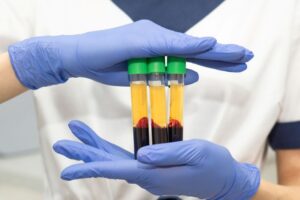
At New England Stem Cell Institute, we often use platelet-rich plasma (PRP) therapy to treat a range of conditions. We want this therapy to be as effective and beneficial as possible, so we pay close attention to new research that highlights how it can be used. In this blog post, we highlight a recent study showing that a proper platelet dose is critical for successful treatment of tennis elbow (technically known as “lateral epicondylitis”).
What Exactly Is PRP?
PRP (platelet-rich plasma) is a therapy used for treating chronic musculoskeletal conditions, such as arthritis, tennis/golfer’s elbow, rotator cuff injuries, plantar fasciitis, and so on. PRP involves drawing blood from the patient (similar to having a blood test), then processing that blood in the office (while the patient waits) to extract the platelets from the blood for injection.
Recall that blood contains red blood cells (RBCs, which carry oxygen), white blood cells (WBCs, which help fight infection), platelets, and liquid plasma. Platelets contain dozens of natural healing proteins and growth factors that help stimulate repair of damaged tissue. With PRP, we harness this natural healing power by injecting damaged or diseased tissue with concentrated platelets to help treat or repair injury.
The Role of Platelet Dose
Research increasingly shows that the NUMBER of platelets injected is critical to successful treatment. In other words, a “one-size-fits-all” approach is inadequate. Sadly, this is still how most clinics and doctors in the country are using PRP. Such practices use a commercial system to process blood to make PRP. These systems produce a standard PRP product that is used for all patients, irrespective of the nature of the problem being treated. This is the equivalent of using one dose of medication to treat EVERY problem.
The current study is known as a “meta-analysis.” These types of studies analyze other studies to see if there is a unifying theme. This study analyzed 13 other high-quality studies. A total of 791 patients were included in the analysis, with 5 studies that utilized low-dose PRP and 8 that used high-dose PRP. The analysis showed that studies that used low-dose PRP resulted in no difference between PRP and all alternative treatment strategies. The platelet concentration factor of PRP used in each study was found to be strongly predictive of outcome. Specifically, a direct linear relationship was observed between the platelet concentration factor of PRP used and the magnitude of patient-reported symptom relief from the PRP treatment.
That might sound a bit complicated, but the bottom line is that, the higher the PRP dose, the better the clinical response. The study authors concluded that, “Clinicians should ensure a supraphysiological platelet concentration when preparing PRP for the management of [tennis elbow].”
Other studies have been done showing a similar link between PRP platelet dose for the treatment of knee osteoarthritis. Specifically, several studies have shown that a minimum of 10 billion platelets need to be injected into the knee joint for optimum response to PRP treatment.
At New England Stem Cell Institute, we’ve been leading the industry for years by customizing the PRP for each patient. And because we use a cell counter to assess each PRP treatment, we can tell you EXACTLY how many platelets are being injected!
Contact us to Learn More
Dr. Paul Tortland is a leader in the field of regenerative medicine, and he is eager to put his knowledge to work for patients. Tailored PRP treatments are among the many services that our team offers. If you have questions about how we may be able to help you enjoy improved health, reduced pain, and other benefits, get in touch with our Glastonbury office at 860-430-2821.
